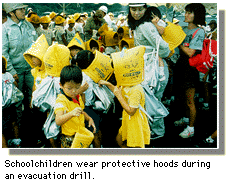 |
What if there's an earthquake at school? |
 |
 At public elementary schools in Japan, earthquake drills are held once a month. If an earthquake strikes while they're in a classroom, children learn to get under their desks, head first, and to hold on to the legs of the desk until the quake is over. After that the teacher leads them out of the building and calls the roll to make sure everybody is there and safe. If a quake hits when the children are in the schoolyard, they are taught to gather in the middle, away from the school building.
At public elementary schools in Japan, earthquake drills are held once a month. If an earthquake strikes while they're in a classroom, children learn to get under their desks, head first, and to hold on to the legs of the desk until the quake is over. After that the teacher leads them out of the building and calls the roll to make sure everybody is there and safe. If a quake hits when the children are in the schoolyard, they are taught to gather in the middle, away from the school building.Sometimes, with help from the local fire department, children also take turns practicing in earthquake-simulation devices, which are special rooms that can be made to shake just as they would in a serious earthquake. At schools with three floors, the older children may also practice using emergency chutes to get to the ground from the top level. Another feature of the drills is to pretend that a fire has broken out and to find a safe way out of the school. The location of the imaginary fire is different every time, so the children can learn what to do no matter where it breaks out. The teachers and children in the upper grades also watch videos to learn how to use fire extinguishers. If a serious earthquake strikes during school hours, the children stay at school with their teachers until somebody from home comes to get them. This is because it may be dangerous for them to try to go home by themselves, or something may have happened to their house or apartment building in the earthquake, and their family may be staying someplace else. The kids also practice waiting at school this way as part of their earthquake drills. When Kobe was hit by a big earthquake in January 1995, many public elementary and middle schools served as emergency shelters for people who had lost their homes. Some of these schools accommodated large numbers of people for several months while temporary new housing was being built. Photo courtesy of Tokyo Metropolitan Government. |
 | |
